Ok – this one is both for my son Zach, and my mom – who both asked about this recipe. Zach is being a huge PIA about it, because the last one I made for him he devoured, so I guess he wants to impress his friends and make one at Auburn…so let’s get on with it.
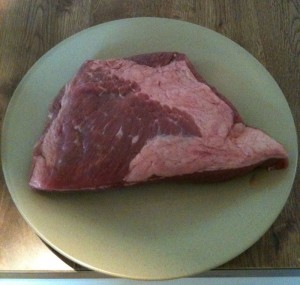 Beef Brisket is one of the easiest things to make – which rules, because it is delicious.
Beef Brisket is one of the easiest things to make – which rules, because it is delicious.
Ideally, you want to cook a brisket with indirect heat for a long time – I use The Beast (my homemade brick BBQ) and oak/hickory when I can, and they come out truly stellar. But sometimes I am stuck inside, so have to use the oven so this recipe is based on oven cooking. If you can manage indirect heat and smoke, that is WAAAY better – but that is not always so easy to accomplish.
But you can see, a brisket is cut leaving a big layer of fat on one side of it – that little bit of meat crawling over the left here in the pic, is not always there – most times, you see only the white fat there. Unlike other types of meats, you want to leave this fat on there – no need to trim it away…it becomes part of your delicious.
This one is about 2 1/2 pounds – typical for this cut. You can get bigger ones – just be clear on your cooking times, and make sure you block out enough time to do it.
The key in a brisket, is cooking it long and slow – letting that fat melt down into the meat, flavoring and tenderizing it wonderfully. So like many long cooked meats, this one is best served by applying a nice dry rub of spices on it to bring out the flavors and character you are after here.
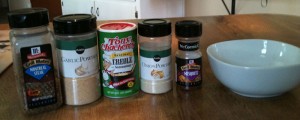 So the rub I like to use, is based on garlic, onion, salt/pepper, and a little hot stuff. You can make one out of whatever you like (and Zach, the one you want used all of the pictured spices plus some thyme). How heavy you go with any of these, or what kind of blend you create is really the signature of the thing here – because this is all there is to a brisket.
So the rub I like to use, is based on garlic, onion, salt/pepper, and a little hot stuff. You can make one out of whatever you like (and Zach, the one you want used all of the pictured spices plus some thyme). How heavy you go with any of these, or what kind of blend you create is really the signature of the thing here – because this is all there is to a brisket.
Whatever you choose to blend for your spices, mix them in a bowl so they are well blended.
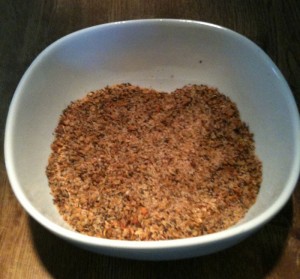 Now I do have to say, I mixed more than I needed for this one – and should have probably simply taken some of that extra, and saved it for something else – but instead, I used it all.
Now I do have to say, I mixed more than I needed for this one – and should have probably simply taken some of that extra, and saved it for something else – but instead, I used it all.
Once the blend is achieved, rub it into the meat – and I mean rub it in there good. You want there to be no more raw meat or fat showing anywhere – it all needs your spicy goodness.
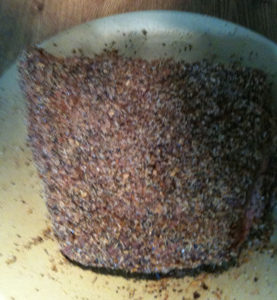 On the right over here, I have the brisket all rubbed down – you can see how thick I went with it. Do you have to go this far? No – but you do want to cover it well, because a brisket on its own is not the most flavorful thing in the world. And going a little heavy is not usually a problem because you cut it into thin strips – so a lot of seasoning on a little part helps to carry it thru.
On the right over here, I have the brisket all rubbed down – you can see how thick I went with it. Do you have to go this far? No – but you do want to cover it well, because a brisket on its own is not the most flavorful thing in the world. And going a little heavy is not usually a problem because you cut it into thin strips – so a lot of seasoning on a little part helps to carry it thru.
But once you have the meat seasoned well, you are almost done with this thing – the hard part is really getting the proper blend of your spices.
The only thing you need to do now, and it is REALLY important – is to make sure the fat side is up – not down. You want that fat to melt, and drip thru your brisket – so having it fat-side up means you are ready to go.
Cooking Your Brisket
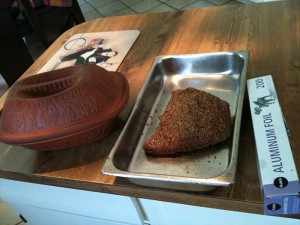 Now, my preferred way to cook a brisket (and a lot of other things) indoors, is using my Romertopf clay cooker. It is over there on the left – and like the name implies, is a clay cooker that treats anything inside it really nicely. But Zach doesn’t have one at Auburn, so I decided I would do this is a simple metal roasting pan.
Now, my preferred way to cook a brisket (and a lot of other things) indoors, is using my Romertopf clay cooker. It is over there on the left – and like the name implies, is a clay cooker that treats anything inside it really nicely. But Zach doesn’t have one at Auburn, so I decided I would do this is a simple metal roasting pan.
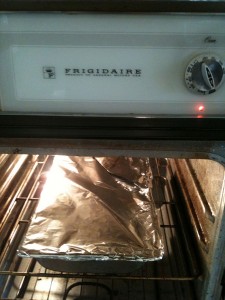 If you are unlucky enough to NOT have a clay cooker yet (eediots!), all you need is a pan big enough to hold it, and some tinfoil to wrap it up tight. Make a good seal around the edges – you are essentially creating a covered dish.
If you are unlucky enough to NOT have a clay cooker yet (eediots!), all you need is a pan big enough to hold it, and some tinfoil to wrap it up tight. Make a good seal around the edges – you are essentially creating a covered dish.
But I don’t even pre-heat the oven for these – I simply put it in there at 275° and let it go.
And yes – I did say 275° – because a low heat is needed to cook it long, and slow. Give it about an hour and a half per pound at that temp. I simply put it in the oven, set my timer, and walk away.
NEVER open the door, or check on it – it is fine, and you don’t want the heat to escape. You don’t baste it, you don’t have to do anything except leave it alone.
Because the one I had was 2 1/2 pounds, I did it for just over 3 hours – at about 280° – because I was timing it for a specific dinner hour. I could’ve gone another hour on it, and it would not have hurt it a bit. But low heat, long time. You go now.
Finishing the Brisket
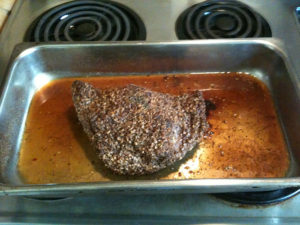 OK – after all that time, I take off the tinfoil, and I have what is actually a pretty dry piece of meat, and some lovely au jus.
OK – after all that time, I take off the tinfoil, and I have what is actually a pretty dry piece of meat, and some lovely au jus.
I let it rest for about 10 minutes, then I take the meat to a cutting board, and pour off that au jus into a bowl, and put a ladle in it – I like it just as it is. You could easily make it into a killer gravy by heating it up and adding a roux, but the jus on its own is super flavorful, and perfect as it is.
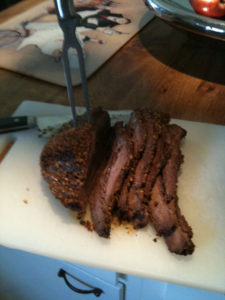 The last thing (before devouring it) is slicing it – go across the grain, and cut it into thin strips. If there is any fat left from the thick strip after cooking, it will be a thin, seasoned layer – and it is truly wondrous.
The last thing (before devouring it) is slicing it – go across the grain, and cut it into thin strips. If there is any fat left from the thick strip after cooking, it will be a thin, seasoned layer – and it is truly wondrous.
That’s it though – slice it thin, serve it with the au jus, and tell ’em Marty sent you. 🙂

Marty,
That looks awesome — I can almost smell it. Great pics – they make me drool!!! Can’t wait to fix one – you can be sure it will be soon!! Thanks for sharing.
Love you, Mom
I learned a lot from your kitchen Mom, and look forward to more. Soon! xxxoo
your recipe looks and sounds great! I have a Romertopf pot.. I assume you season the same. how long does it cook in the clay pot? and if you have two briskets can you lay one on top of the other when cooking? I have used my Romertopf pot for chickens and turkey and applesauce. never for beef so I’m not sure of the cooking time.
thanks so much,
Pam
another question… DO you need to add liquid to the pot when making the brisket and are you cooking at a temperature lower than 425?
Hi Pam–I find with the clay cooker, typically it simply shaves time off (like maybe close to a hour of needed time) – or, you can even make the temperature slightly less because the clay holds the heat so well. If the heat is low enough, I don’t find more time to be a bad thing really- but you have to be careful of the heat, ’cause it can dry it out a little if you are not careful. The Romertopf pools the jus of whatever I have cooked in there, but I have over done meat because I left it too hot, too long in the clay buddy. I don’t add more liquid to the clay cooker with a brisket- you certainly could, and lots of folks do. I kinda like the meat to be a little bit drier, so it holds its texture and body, then using the au jus to soften it back up (the jus is REALLY good from a brisket). If so, I would use very minimal liquid, as the cooker kinda works that way on its own – but using something like apple juice, or a Worcestershire mix might add a nice flavor to it too. With everything like this, I would do trial and error to find what you like best- and if you keep in mind that too hot, too long is your biggest worry, turning down the heat works well for most things in the cooker.
I will say, one thing to try in the cooker is a pot roast – I make those more often than the briskets for sure, and the Romertopf does an AMAZING job on them. When I remember to, I soak my cooker in water for a half hour before starting and I don’t preheat the oven – just turn it on, and go. That was the suggested way to do it, but I forget sometimes – it does help to allow the cooker to do more for you though. Mine is about 24 years old, so it is seasoned nicely – I have definitely been a huge fan of anything done in it. If you do a pot roast, the only thing to remember is to add potatoes/veggies later, or they have a tendency to really mush up. But do the meat a couple hours, then add the veggies for the last 1-2, and you’ll be singing. 🙂 Thanks for the kind words- and happy cooking to you!! Cheers, m
Thanks so much for your ideas. How many pounds of brisket and length of time should I do in the tomertoph? At what temp should I do it? I. Dec to feed 6-8 people for dinner. Thanks you!!
Hey Marilyn – for the weight, I usually aim at about a half pound per person, depending on things being served with it. You’d hate to run out, but brisket is costly, so make up for it in mashed potatoes, when you can. 🙂 Most people won’t eat a half pound of meat when other things are served with it, so it keeps you safe.
The temp is a thing you may wanna feel out – but if you go hotter and shorter, you’ll retain more of the meat’s body…lower and slower, makes it more of the soft pull stuff. Again, to me, it depends on how much time I have – if I have more, I aim for that – but less time with a clay cooker, just means jack the heat up a little, and let the clay protect you. It works – go to like 425-450, and it gets done more quickly, and you can shorten the cook time and slice it better sometimes. If you have a meat thermometer, you can stick that in there to be sure, but higher temps mean less time, or you will make soup of everything. A delicious soup to be sure, but that may not be what you want with folks over to eat.
But your exact cooking time, should be based on the weight of the meat, the extra stuff you put in the cooker with it and the temp you are using – are you going low and slow, or within a shorter time frame?
6-8 folks is a big crew, so I would go about 5-6 pounds of meat, depending on the makeup of the guests. My brothers were big and ate tons, and I like to make more than I need. Leftover brisket cooked right, is not gonna suck. Good luck with it!
Could you please list the seasoning that you pictured for Zack? I can’t make out what they are. I made this is the past and it turned out awesome but I guess my eyes grew older and now I can’t see which seasoning is to be used
Hi Danielle – That one used the following I think: Montreal Steak Seasoning (A premix, that has lots of pepper and salt), Garlic powder, Onion powder, Tony Chacero’s Cajun Seasoning (just a decent seasoning mix that has a bit of heat), some allspice – and typically I’d add some thyme, rosemary, basil and maybe a little oregano to get in some greens. The Montreal Steak uses coarse salt and big pepper chunks, so Zach always had it and used it as a base, cutting it with the other spices to add dimension. He would add things like marjoram or sage, but the dry rub spices would tend to be pretty similar to what I described. I think, you should have fun with it – a garlic/onion powder base with salt and pepper, and some off the shelf cajun spices will produce some terrific results for you. Bon appetit!
Awesome recipe, thank you so much. We used a Römertopf and after 5hrs, our 5lbs piece came out just perfect!
Greetings from Germany,
Thomas &Katrin
Hi Thomas and Katrin – That is so good to hear! 5 lbs at 5 hours is making my mouth water, just thinking about it…awesome! Eat well my friends – Marty
At what temp?
Hey Beverly – Not sure if you meant this for me, but temps are something I am experimenting with a LOT with my clay cooker. I love the fact it can take a pretty high heat, and likewise, can bring greatness to a slow-cooking effort.
I find, go hotter and less time, and you will still cook things all the way thru, but they don’t get as shreddy/fall-apart. Slow and low, and you get a different benefit from the cooker – so you should try a couple different temps on a recipe, and get a feel for it…I find that helps the most, knowing how to approach your next time out. Cheers, – Marty
I have my grandmother’s Romertof which she bought in 1967 visiting her son on military serve in Germany. It’s well seasoned by both her cooking and my own. It’s great for roast chicken, pheasants and doves- from my own hunting, but I’m going to try it with brisket for the first time. Do you ever “bard” the meat? Fore doves I use pancetta.
Wow Michael – just that message, made me hungry, and start to think of what to do in the cooker. Skin-on birds come out wonderfully, so your wild game must be insanely awesome! I have not tried to bard the meat before, but most of the things I do have a nice bit of fat in them on their own…I do love to bard buffalo, because it is lean, and bacon fat makes it more succulent and tender.
I also think the older your cooker is, the better it is – I hope my son can inherit mine one day – gotta be careful to treat it well! Thanks for the comment, and happy cooking to you! Cheers, Marty